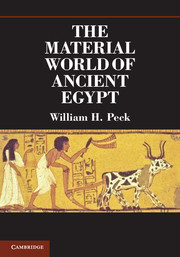Book contents
- Frontmatter
- Contents
- List of Figures
- Preface
- Acknowledgments
- Introduction
- 1 Geography and Geology
- 2 Brief Outline of Egyptian History
- 3 Study of the Material World of Ancient Egypt
- 4 Dress and Personal Adornment
- 5 Housing and Furniture
- 6 Food and Drink
- 7 Hygiene and Medicine
- 8 Containers of Clay and Stone
- 9 Tools and Weapons
- 10 Basketry, Rope, Matting
- 11 Faience and Glass
- 12 Transportation
- 13 Sport and Games
- 14 Music and Dance
- 15 Weapons and Armor
- 16 Conclusions
- Sources of Chapter Heading Quotations
- Bibliography
- Index
6 - Food and Drink
Published online by Cambridge University Press: 05 August 2013
- Frontmatter
- Contents
- List of Figures
- Preface
- Acknowledgments
- Introduction
- 1 Geography and Geology
- 2 Brief Outline of Egyptian History
- 3 Study of the Material World of Ancient Egypt
- 4 Dress and Personal Adornment
- 5 Housing and Furniture
- 6 Food and Drink
- 7 Hygiene and Medicine
- 8 Containers of Clay and Stone
- 9 Tools and Weapons
- 10 Basketry, Rope, Matting
- 11 Faience and Glass
- 12 Transportation
- 13 Sport and Games
- 14 Music and Dance
- 15 Weapons and Armor
- 16 Conclusions
- Sources of Chapter Heading Quotations
- Bibliography
- Index
Summary
On that day the workman Menna gave the pot of fresh fat to the chief of the Medjay [police] Mentmose who said “I will pay you for it with barley.”
Memorandum of payment owedOne of the most important and characteristic aspects of any civilization is the way that people were able to nourish themselves, the kinds of food and drink that were available to them. In a culture with the geographical advantages of ancient Egypt, where the fertile land was renewed yearly by the annual flooding of the Nile, the production of abundant food crops was usually a dependable resource (Fig. 38). With the assurance that fields would be refreshed with new silt and that water was plentiful, the people of Egypt were confident that they were provided for by the gods. Egypt remained basically an agricultural land with a society that was based on the tilling of the soil, and agriculture in one form or another was the main occupation of the greater part of the population.
Food was plentiful except in times when the annual flood was irregular, either too low or too high. To counter periods of inadequate production or natural threats to the supply, the Egyptians developed methods of food storage and preservation early in their history. The plagues described in the Bible certainly give some indications of the natural phenomena that had their effects on Egyptian agriculture. These exceptional occurrences could possibly be anticipated and provided for by stockpiling foodstuffs. It is probable that all levels of the population had enough to eat, although times of famine were also recorded. The primary difference was that the higher classes had larger resources to choose from and consequently a more varied diet.
- Type
- Chapter
- Information
- The Material World of Ancient Egypt , pp. 93 - 109Publisher: Cambridge University PressPrint publication year: 2013
- 1
- Cited by

